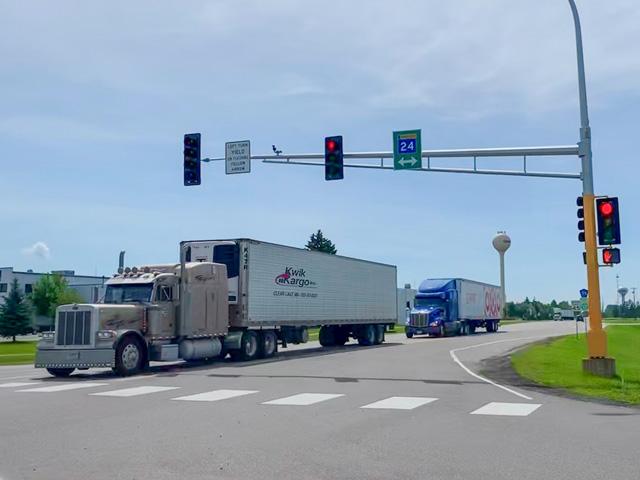New Standards for Training Truckers
Federal Program for New Truckers Aims for More Uniform Training Standard, Safety Benchmark Nationally for CDL
OMAHA (DTN) -- Farmers and others looking to get a commercial driver's license (CDL) will now be required to get federally approved training before they are eligible to take the CDL test.
The new federal training standards went into effect on Monday, though the trucking industry has been working for a decade to get the new rules in place.
Called the Entry-Level Driver Training (ELDT) rule, the new standards apply to people looking to get a Class A or Class B CDL for the first time, or upgrading a Class B CDL to a Class A. The rule also applies to people looking to drive a school bus or other passenger bus, as well as anyone getting an endorsement such as hauling hazardous materials.
Farmers are typically exempt from CDL requirements if they drive within a 150-mile radius of their farm. The new rules will affect those producers who need to haul farther distances but did not receive a CDL license before Monday, Feb. 7.
The ELDT requirements are not retroactive for drivers with CDLs or certain driver endorsements before Feb. 7, or their renewals.
The tighter rules on CDL tests have been planned since the 2012 highway bill, "Moving Ahead for Progress in the 21st Century Act," was signed into law. Initially, the ELDT was set to begin in 2020, but the mandate was delayed for two years.
P[L1] D[0x0] M[300x250] OOP[F] ADUNIT[] T[]
The goal was to set a minimum, more uniform standard for training and safety benchmark nationally for all new drivers. The ELDT mandate also means many businesses will no longer be allowed to train their own drivers. The rule requires both classroom "theory" teaching and behind-the-wheel instruction with an emphasis on basic operation of a truck, as well as rules such as hours of service. The rule does not set a minimum number of hours for instruction, but the written test requires a minimum score of 80%.
From now on, entry-level drivers will have to select a training provider listed in the federal Training Provider Registry on the Federal Motor Carrier Safety Administration (FMCSA) website. (See https://tpr.fmcsa.dot.gov/…)
Nationally, there are more than 13,300 locations around the country listed on the Training Provider Registry.
Still, the new rule kicks in as the country also faces an all-time high trucker shortage with an immediate need for roughly 80,000 truckers, according to the American Trucking Associations (ATA). Even as the new rule goes into effect, Department of Transportation (DOT) last month loosened rules to allow states to waive certain test requirements for CDL licenses to help deal with school bus driver shortages nationally.
The new rule also comes into effect following the DOT announcing a national apprenticeship program to recruit employers willing to launch a pilot program for drivers ages 18 to 21 years of age. The infrastructure bill passed last November requires DOT to create a program that would allow younger CDL drivers to haul goods across interstate lines. DOT is still working on an apprenticeship program.
Groups that represent truckers noted that plans for setting a single standard for national training have been in the works for a decade now.
While the new requirements are likely to draw criticism, groups such as the Truckload Carriers Association backed the new rules as "beneficial to set a national proficiency minimum that promotes safety and preparedness," the group wrote in an op-ed.
"These safety improvements could potentially help reduce the industry's driver shortage and retention concerns. Increased driver safety and proficiency could improve driver satisfaction and increase career longevity," TCA representatives wrote on a trucking website, Freightwaves.com. (See https://www.freightwaves.com/…)
Yet, drivers who cannot afford to pay for a training school, or those who struggle with English literacy are likely to have a difficult time meeting the new requirements.
The ATA highlighted that the new rules will not change much for most organizations that already have a training program in place. "Despite false rumors spreading on social media, the process for obtaining a CDL will not markedly differ from what takes place today. Prospective drivers will be required to pass a theory/knowledge test and a road/skills test," ATA's Dan Horvath, vice president of safety policy, wrote in a column.
ATA noted the new rule "simply means everyone will be using the same curriculum nationwide. In fact, FMCSA estimates 85% of entry-level drivers already receive training curricula that meets the ELDT requirements." (See https://www.trucking.org/…)
More information can be found on the FMCSA website at https://www.fmcsa.dot.gov/…
Chris Clayton can be reached at Chris.Clayton@dtn.com
Follow him on Twitter @ChrisClaytonDTN
(c) Copyright 2022 DTN, LLC. All rights reserved.




